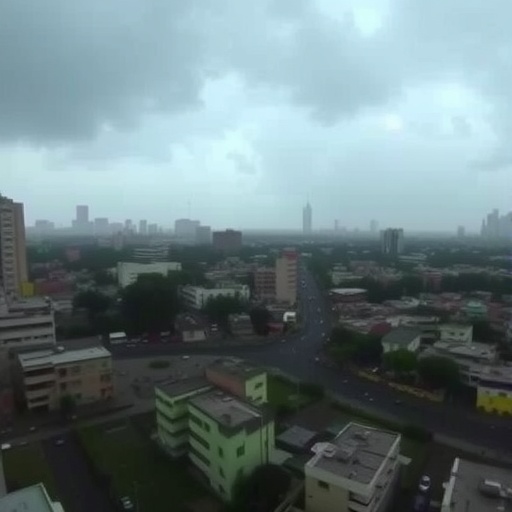Unlocking Climate Mysteries: How Past Warm Periods Illuminate the Future of the South Asian Summer Monsoon
The South Asian summer monsoon, a critical climate phenomenon sustaining nearly two billion people, stands at the crossroads of dramatic change under global warming. Recent investigations reveal a perplexing paradox: while future projections indicate increased monsoon rainfall, the circulation that traditionally drives the monsoon appears to weaken. This contradictory dynamic has long confounded scientists attempting to predict how climate change will reshape this vital system.
Historically, warmer climates—such as those during past interglacial periods—exhibited not only heightened precipitation but also a pronounced strengthening of monsoon circulation. This historical concurrency contrasts sharply with the divergent future forecast where rainfall intensifies without the expected reinforcement of atmospheric flows. The discrepancy challenges prevailing theories and calls for a deeper, more nuanced understanding of monsoon response mechanisms amid warming.
A breakthrough study led by He, Zhou, and Guo integrates an unprecedented synthesis of ancient climate proxies and advanced climate models spanning multiple warm intervals—the mid-Pliocene, the Last Interglacial, and the mid-Holocene—alongside simulations of future climate scenarios. Their approach delves into the complex interplay between thermodynamics and atmospheric dynamics, unraveling the multifaceted drivers behind monsoon evolution.
The investigation reveals a consistent pattern across warm climates: an overall increase in monsoon rainfall coupled with a weakening of monsoon trough-like circulation specifically over the Bay of Bengal, while simultaneously showing a strengthening of monsoon circulation over the northern Arabian Sea. This spatial heterogeneity suggests that the monsoon system cannot be simplistically interpreted as uniformly intensifying or weakening but must be appreciated as regionally differentiated.
Central to these findings is the thermodynamic dominance of atmospheric moisture availability. Following the ‘rich-get-richer’ paradigm, warming enhances the atmosphere’s moisture-holding capacity, thereby fueling stronger precipitation. This effect acts in concert with dynamic influences that are themselves spatially variable, dictated largely by regional land surface warming patterns.
Particularly influential is intensified land warming in subtropical western Eurasia and northern Africa, which bolsters monsoon circulation through enhanced thermal contrast. This thermal gradient energizes atmospheric flows over the northern Arabian Sea, while the circulation over the Bay of Bengal weakens, reflecting complex feedbacks between land and ocean temperature changes.
The study’s comprehensive proxy compilation demonstrates that previous warm periods are invaluable analogues for future climatic behavior. By leveraging palaeoclimate reconstructions, the authors reconcile past monsoon circulation strengthening with anticipated future weakening, bridging a crucial gap in understanding and improving confidence in projections.
Further, the researchers employ physics-based regression models grounded in past climate data to predict future monsoon variables. These models exhibit impressive agreement with cutting-edge climate simulations, underscored by strong spatial correlation coefficients nearing 0.8 for circulation and 0.7 for rainfall under high-emission scenarios. Such statistical robustness highlights the promise of integrating palaeoclimate insights into predictive frameworks.
This multidisciplinary endeavor underscores an emerging paradigm in climate science: the fusion of deep-time perspectives with modern modeling to holistically interpret and anticipate climate system responses. Through this lens, the South Asian monsoon’s future appears less enigmatic, offering clearer signals amid the noise of climate uncertainty.
Beyond academic insight, these findings carry profound implications for millions dependent on monsoon rains for agriculture, water resources, and livelihoods. Clarifying the future behavior of monsoon circulation and precipitation patterns equips policymakers and stakeholders with more reliable predictions essential for adaptation and risk management.
The nuanced understanding of how regional land warming modulates monsoon dynamics can inform targeted strategies to mitigate adverse impacts and harness potential benefits. Particularly, recognizing the differential influences over the Arabian Sea and Bay of Bengal regions provides a spatial framework to anticipate localized climate shifts.
Moreover, the integration of proxy records and modeling opens avenues for refining climate projections across other monsoon systems globally, suggesting broader applicability of this methodology to anticipate monsoon responses under warming.
This pivotal research illuminates the value of palaeoclimate archives in deciphering contemporary climate challenges. By looking into Earth’s warm past climates, scientists enhance foresight into the monsoon’s future trajectory, offering a beacon of understanding as the planet navigates unprecedented change.
As climate models continue to evolve, the fusion of observational proxies with sophisticated simulations promises ongoing advances in monsoon science. This approach exemplifies how reconciling data across temporal scales deepens our grasp of atmospheric processes essential for sustaining human and ecological systems alike.
Subject of Research:
The response of the South Asian summer monsoon to warming climates, combining palaeoclimate proxies and climate model simulations.
Article Title:
Past warm intervals inform the future South Asian summer monsoon.
Article References:
He, L., Zhou, T. & Guo, Z. Past warm intervals inform the future South Asian summer monsoon. Nature 641, 653–659 (2025). https://doi.org/10.1038/s41586-025-08956-6
Image Credits:
AI Generated




